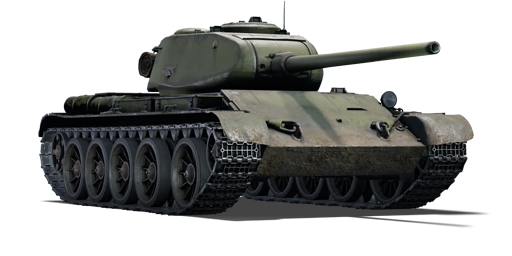



The T-44 is a Soviet medium tank. It was introduced during the Closed Beta Test for Ground Forces before Update 1.41. A vastly improved tank over the T-34 series, the T-44 features similar mobility with much better frontal armour protection.
As a direct successor of the T-34-85, the T-44 truly was a pioneering tank construction, paving the way for many modern Soviet tanks. It provides great mobility and a good degree of armour protection. Veteran players with the T-34-85 will instantly recognize the turret and the gun, as the T-44 is armed with the same ZiS-S-53 85 mm gun as the T-34-85, but there are no more further similarities between the two. The T-44 expresses a different and more modern-looking layout of the tank compared to the T-34, with the turret now in the middle of the hull, and the tank is noticeably lower to the ground, with an extremely sloped frontal armour plate. The resulting silhouette is nearly half of the T-34-85, making the T-44 a much smaller target. These changes were made possible mainly by one important aspect of the construction - the relocation of the engine, a V-44 V12 diesel engine producing 500 horsepower, to a position perpendicular to the axis of the tank. This change, along with the removal of hull sponsons, allowed the crew compartment to be built with more space, and subsequently more comfortable for the crew even for a smaller tank.
Off-road performance and mobility drops compared to the T-34-85 due to the T-44's increased weight. However, the T-44 inherits a great degree of mobility from the T-34 thanks to its wide tracks. On paved surfaces, the T-44 reaches a top speed up to 60 km/h, has very good acceleration and, with a trained driver, is pleasantly agile as well. Combine this with the mentioned low profile and the T-44 can zip around the map and reach a desirable firing position quickly. Use its speed and impressive agility to worm into unexpected places and fire on the enemies' sides. However, be careful when engaging enemies frontally, particularly heavy opponents, as the ZiS-S-53 is no longer a powerful armament at its BR. This makes it difficult, if not impossible, to penetrate more heavily-armoured opponents frontally.
| Ammunition | Type | Armor penetration (mm) at a distance: | |||||
|---|---|---|---|---|---|---|---|
| 10 m | 100 m | 500 m | 1000 m | 1500 m | 2000 m | ||
| APHE | 148 | 143 | 126 | 106 | 90 | 77 | |
| HE | 19 | 18 | 17 | 16 | 15 | 14 | |
| APHEBC | 135 | 133 | 124 | 114 | 104 | 95 | |
| APCBC | 164 | 162 | 154 | 143 | 134 | 125 | |
| APCR | 195 | 187 | 154 | 122 | 96 | 76 | |
| APCR | 208 | 201 | 176 | 148 | 125 | 106 | |
| Belt | Belt filling | Armor penetration (mm) at a distance: | |||||
|---|---|---|---|---|---|---|---|
| 10 m | 100 m | 500 m | 1000 m | 1500 m | 2000 m | ||
| AP-I/API-T | 13 | 12 | 7 | 3 | 2 | 0 | |












Mobility | |
|---|---|
Protection |
|---|
Firepower | |
|---|---|